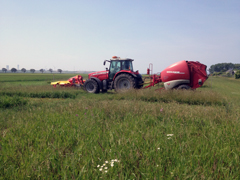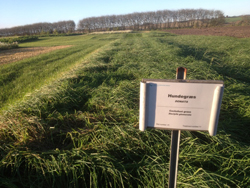Enhancing biomass production from marginal lands with perennial grasses (GrassMargins)
Perennial grasses, which once established can be harvested and re-grow annually for many decades, have a number of other beneficial characteristics which suit them as biomass crops. These include high resource use efficiency, high productivity, good environmental qualities and a wide range of end uses. Environmental benefits include high rates of soil carbon sequestration, enhanced biodiversity and soil stabilisation. Furthermore, perennial grasses naturally colonise marginal areas of land which often impose severe restrictions on the growth of vegetation. Marginal land is defined as land of poor quality for agriculture and which yields poor returns for the farmer. The aim of this project is to identify, characterize and develop novel varieties of C3 grasses (Dactylis glomerata, Festuca arundinacea and Phalaris arundinacea) and the C4 genus Miscanthus that show high and stable productivity and require the minimum of additional inputs when grown on different forms of marginal land. In broad terms the work will contribute to overcoming specific bottlenecks along the whole perennial grass-based production chain. In particular it will use modelling to identify the optimal characteristics and geographical distribution of perennial grasses of potential use for biomass production, undertake pre-breeding of novel varieties, investigate stress tolerance and develop drying characteristics following harvest. The consortium assembled to achieve these outputs consists of 12 partners from eight countries representing Northern, Central and Western Europe and partners from Russia and China and involves three SME partners.
Funding: FP7-EU commission (2011-2015)
Project website: http://www.grassmargins.com/
Project leaders: Linda-Maria Mårtensson, Georg Carlsson and Erik Steen Jensen
Collaborators: Thomas Prade, Sven-Erik Svensson
Partners: Teagasc (Coordinator Ireland), Aarhus University, University of Sheffield and more
Publications:
Mårtensson et al. 2017. Water use efficiency and shoot biomass production under water limitation is negatively correlated to the discrimination against 13C in the C3 grasses Dactylis glomerata, Festuca arundinacea and Phalaris arundinacea. Plant Physiology and Biochemistry. DOI: 10.1016/j.plaphy.2017.01.021
Carlsson, G. et al 2016. Perennial species mixtures for multifunctional production of biomass on marginal land. Global Change Biology Bioenergy DOI - 10.1111/gcbb.12373.


Cocksfoot (Dactylis glomarata) and other grasses in field plots (Photo Erik Steen Jensen)